
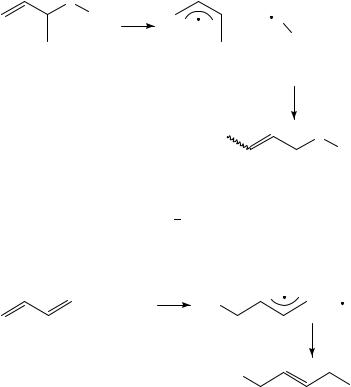
13. Radical addition to polyenes |
639 |
The same intermediate radicals can be formed by photolysis of the mixed diacyl peroxide 3670. The resulting radical pair recombines, after decarboxylation, in a ratio of 92:8 (equation 16). The higher regioselectivity in this latter case appears to result from the limited mobility of the intermediate radicals in the solid state (at 78 °C). This experiment illustrates that a meaningful comparison of selectivities requires experimental data obtained under comparable reaction conditions. Photolytically generated radical pairs have also been used to investigate the regioselectivity in the recombination of allyl radical 38 with thiophenyl radical 39. Terminal trapping is, as seen before for radical 32, the preferred mode of action since photolysis of thiol ether 37 gives product 40 exclusively (equation 17)71.
S
Ph |
hν |
|
+ |
S |
|
|
|||
|
|
|
Ph |
|
|
|
|
|
|
(37) |
|
(38) |
|
(39) |
(17)
S
Ph
(40)
Many more examples have been collected for the reaction of transition metal hydride complexes with 1,3-dienes, which appear to proceed via radical pair mechanisms, even without photochemical activation72 77. The following general mechanism has been assumed to be operative for the reaction of HMn(CO)572,73, HFe(CO)4SiCl374,75, HFe(CO)2Cp76 and HCo(CO)4 (H-[M]) (equation 18)77.
+ H−[M] |
H |
+ [M] |
(18)
H
[M]
The mechanistic proposal of rate-limiting hydrogen atom transfer and radical recombination is based on the observed rate law, the lack of influence of CO pressure, kinetic isotope effects [studied with DMn(CO)5] and CIDNP evidence. In all known cases, exclusive formation of the overall 1,4-addition product has been observed for reaction of butadiene, isoprene and 2,3-dimethyl-1,3-butadiene. The preferred trapping of allyl radicals at the less substituted side by other radicals has actually been so convincing that its observation has been taken as a mechanistic probe78.
Oxygen can also be considered an open-shell trapping agent in its ground state triplet state. An example for the highly regioselective trapping of a sterically demanding allyl radical by oxygen has been provided in the study of the biomimetic synthesis
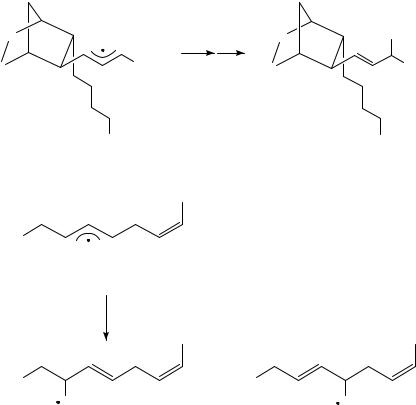
640 |
H. Zipse |
of prostaglandins62. As seen before in the tin hydride trapping of allyl radicals, the bicyclic substituent in 41 reduces the reactivity of one of the allylic radical centers dramatically and reaction occurs regioselectively only at one end of the allyl system to yield hydroperoxide 42 (equation 19)79. Trapping by oxygen proceeds much less selectively in more symmetrically substituted allyl radicals such as 43, which yields peroxy radicals 44 and 45 in a ratio of 27:73 (equation 20)79.
O |
|
O |
O2 H |
|
|
O2 |
|
O |
C5H11 |
O |
C5H11 |
CO2 Me |
|
CO2 Me |
(41) |
|
(42) |
|
|
(19) |
PhS |
|
|
(43) |
|
|
EtOA c/Hexane, 25˚C O2 |
|
(20) |
PhS |
+ |
PhS |
O2 |
|
O2 |
(44) |
|
(45) |
27 |
: |
73 |
A number of earlier investigations of the regioselectivity in the reaction of allyl radicals with other radicals has been plagued by severe analytical problems41,80.
C. Dimerization of Allyl Radicals
The regioselectivity in the dimerization of allyl radicals has been studied by a variety of methods. One of the earliest investigations into this field employed the Kolbe electrolysis
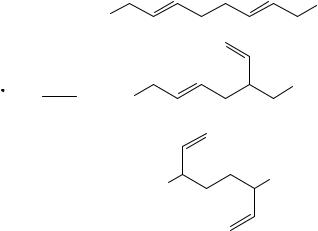
13. Radical addition to polyenes |
641 |
to generate carboxylate derived radicals in the presence of dienes49. The complex product mixture obtained could only be analyzed at that time to contain major amounts of product resulting from recombination at the least substituted allyl terminus. The same difficulty was encountered in the dimerization of allyl radicals, which result from the addition of alkoxy radicals to butadiene81a. Again, the major product appeared to result from recombination at the less substituted center of the intermediate allyl radical. Generally, the recombination of allyl radicals with an unsymmetrical substitution pattern can produce (1,1)-, (1,3)- or (3,3)-coupling products (Scheme 3). Products (1,1) and (1,3) frequently occur as mixtures of Z- and E-isomers.
Product
R (1,1)
R
3 1
R
 R
R
R (1,3)
R
R |
(3,3) |
|
SCHEME 3
Assuming that the allyl C1 and C3 centers have an intrinsic reactivity, which is independent of the direct coupling partner (C1 or C3 of the second allyl radical), the results of a variety of different experimental investigations can be examined comparatively. If this assumption holds true, the relative product distribution for an allyl radical with intrinsic reactivity of A at C1 and of B at C3 should be given by equation 21.
1, 1 : 1, 3 : 3, 3 D A2 : 2AB : B2 |
21 |
Despite the fact that a quantitative product analysis is often difficult to achieve in these reactions, the product distribution expected from equation 21 is indeed found in many cases. Table 14 lists some representative examples.
In all cases, reaction at the less substituted allyl terminus is preferred by a factor of two or more, even though the actual degree of regioselectivity depends strongly on the substitution pattern. Those cases in which the product distribution deviates strongly from that predicted by equation 21 include allyl radicals connected to other -systems. A point in case is the recombination of 1-ethyloxycarbonyl allyl radical 46, which predominantly yields the (1,3)-recombination product (equation 22)71.
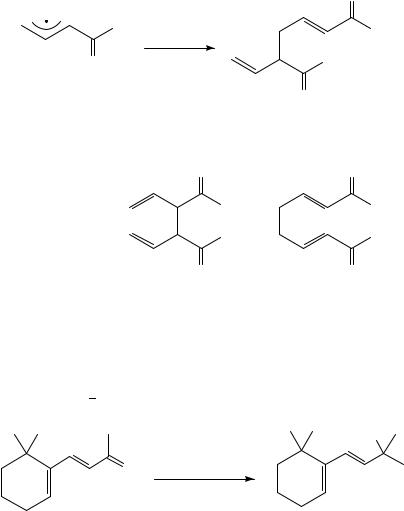
642 |
H. Zipse |
|
|
|
O |
|
OEt |
OEt |
|
Dimerization |
|
|
|
|
|
O |
OEt |
|
(46) |
O |
|
|
|
|
|
(1,3) |
|
|
65% |
|
|
(22) |
|
O |
O |
|
OEt |
OEt |
|
OEt |
OEt |
|
O |
O |
|
(3,3) |
(1,1) |
|
19% |
16% |
The product distribution observed in the dimerization of polyene-substituted ketyl radicals is also remarkable in that only products involving dimerization at the carbonyl carbon atom are observed (equation 23)82,83. This finding is quite independent of the reducing agent, since ketyl radicals formed by reduction with low-valent transition metal complexes behave analogously84 86.
HO
)
O |
+e− |
2 |
CH3 CN/CH3CO2H
(23)
In summary, it appears that the trapping of allyl radicals with closed-shell trapping agents is quite selective, especially in those cases in which the allyl radical contains one substituted and one unsubstituted terminus. Trapping with radicals appears to produce mixtures of isomers, especially in the dimerization of allyl radicals. The observed regioselectivities do, however, depend on the reaction conditions, allowing for some control of the reaction outcome for a given substrate.
Reviewing now the last four sections, it is obvious that the major problem in radical chain reactions involving dienes or polyenes is the low reactivity of the diene (or polyene) adduct radicals. This allows for the occurrence of allyl radicals in intramolecular reactions but poses a major problem in intermolecular radical chain reactions. The obvious solution to this problem is to use methods in which radicals are produced stoichiometrically and not

13. Radical addition to polyenes |
643 |
TABLE 14. Relative reactivities at allyl radical termini calculated from product distributions from allyl radical recombination
Relative reactivities |
T °C |
Method |
Reference |
|
>3.9 |
<1 |
|
|
|
|
SO2 Ph |
78 |
Carbanion oxidation |
81b |
|
|
|
|
|
2.71
|
0 |
Kolbe electrolysis |
81c |
|
CO2 Et |
|
|
2.9 |
1 |
|
|
|
0 |
Kolbe electrolysis |
81c |
CO2 Et
1.71
|
35 |
Photolysis |
71 |
1.9 |
1 |
|
|
|
10 |
Kolbe electrolysis |
81d |
1.91
|
10 |
Kolbe electrolysis |
81d |
2.5 |
1 |
|
|
|
0 |
Kolbe electrolysis |
54b |
H>4.0 <1.6 |
|
|
|
|
20 |
Diene addition |
54a |
>6.9 |
<1 |
|
|
|
0 |
Kolbe electrolysis |
81d |
|
CO2 Et |
|
|
in radical chain processes. Not surprisingly, most examples of the successful use of dienes in radical reactions are located in this area. Even though the use of non-chain methods does solve the problem of adduct radical reactivity, the problem of competing polymerization still persists. It is therefore mandatory also for nonchain methods to convert the adduct radicals to product faster than addition to a second polyene molecule. With the trapping of polyene radicals by closed-shell molecules being too slow, three further possibilities exist: (1) trapping with other radicals; (2) oxidation to polyene cations; or (3) reduction to polyene anions. Since option (1) has been shown before to proceed with low selectivity at times and not much is known about option (3), we have to restrict ourselves here to consideration of (2), which has been applied successfully in many cases.
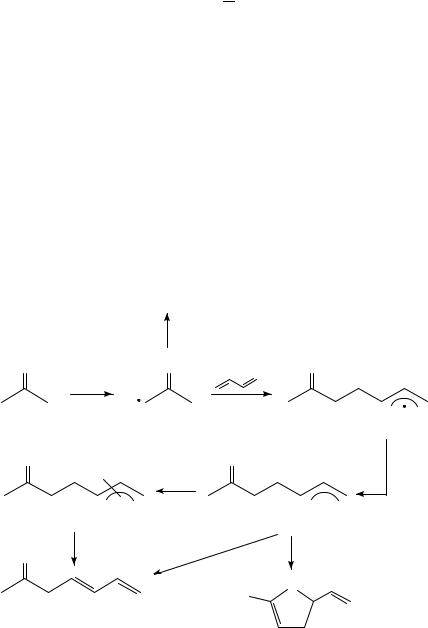
644 H. Zipse
VI. NON-CHAIN RADICAL REACTIONS OXIDATION AS AN ALTERNATIVE
TERMINATING STEP
A general mechanistic scheme for the radical addition-adduct radical oxidation sequence is given in Scheme 4. Initial radicals are usually derived from easily enolizable compounds such as ketones, esters and, most frequently, 1,3-dicarbonyl compounds by oxidation with metal salts. The resulting ˛-carbonyl radical 47 is more difficult to oxidize and addition to dienes can occur. The resulting adduct radical 48 has a much lower oxidation potential as compared to 47. Oxidation to cation 49 is therefore faster than repeated addition to diene molecules and polymerization can be prevented. Depending on oxidants and reaction conditions, a number of possibilities exist to convert cation 49 to stable products. Trapping of the cation by nucleophiles is frequently observed to produce products of type 50, which can also be formed directly through inner-sphere electron transfer to radicals 48. Cation 49 can also deprotonate to form 51, which can alternatively be formed via 50 through elimination of HX. Finally, 49 is often trapped intramolecularily by the carbonyl functionality of the initial radical to form, after deprotonation, substituted diand tetrahydrofurans such as 52. If carboxylic acids or esters are used as enolizable compounds, -lactones are formed instead. For this mechanistic scheme to work, the oxidant must be strong enough to effect
O
+
(53)
− e−
O |
O |
|
O |
|
− e- |
|
|
|
−H+ |
|
|
|
(47) |
|
(48) |
O |
X |
O |
− e− |
|
+ X− |
|
|
|
|
|
+ |
|
(50) |
|
(49) |
|
−HX |
−H+ |
−H+ |
O |
|
||
|
|
|
|
|
|
|
O |
|
(51) |
|
|
|
|
|
(52) |
|
|
SCHEME 4 |
|
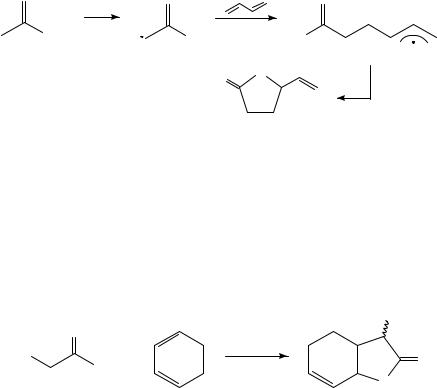
13. Radical addition to polyenes |
645 |
rapid oxidation of the enolate and the adduct radical 48. If the oxidant is too strong, however, oxidation of enol radical 47 to form cation 53 will be too rapid and no addition to diene will be observed.
Among the preferred and also first oxidants to be used for this purpose was manganese(III) acetate in acetic acid, for which the formula Mn3O(OAc)7 might be appropriate53,87. Oxidation of acetic acid, for example, leads to radical 54 which, upon addition to butadiene and oxidation of the adduct radical, leads to -lactone 55 (equation 24).
O |
− e− |
O |
|
O |
|
|
|
|
|
|
|
OH |
−H+ |
OH |
|
HO |
|
|
|
|
|||
|
|
(54) |
O |
O |
(24) |
|
|
|
|
||
|
|
|
−H+ − e |
− |
|
|
|
|
|
(55) 30%
The low yield in this reaction might be caused by a number of reasons. First, the overall reaction is only rapid for readily enolizable compounds. 1,3-Dicarbonyl compounds will therefore be a better choice as compared to acetic acid. Second, to prevent oxidation of radical 54, it is advantageous to work with excess diene and therefore speed up trapping of 54 through diene addition. Finally, lactone 55 can, as an enolizable compound itself, also be oxidized by manganese(III) acetate and form various oxidation products. Shorter reaction time and the use of understoichiometric amounts of oxidant might therefore benefit the overall result. All these factors have been taken into account in the synthesis of bicyclic-lactone 56, which has been obtained from cyanoacetic acid and 1,3-cyclohexadiene in 78% yield within 15 min reaction time (equation 25)60,88.
|
|
|
CN |
|
|
O |
|
|
|
NC |
+ |
‘Mn(III)’ |
O |
|
HOAc |
||||
|
OH |
|
||
|
|
15 min, 23˚C |
O |
(56) 78%
25
Using esters instead of acids reduces the rate of formation of lactones and gives rise to trapping by solvent as well as the formation of overall diene substitution products. Oxidation of amidomalonic ester 57, for example, yields as major products the acetic acid trapping product 58 and the diene substitution product 59, but only 5% of lactone 60 (equation 26). The oxidation of the initially formed amidomalonic ester radical, of increased importance in this case due to the amide substituent, could be largely reduced through addition of sodium acetate or trifluoroacetic acid, which are known to reduce the oxidation potential of the Mn(III) acetate.
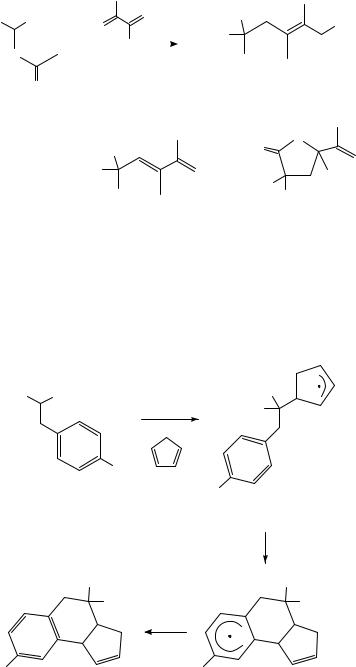
646 |
|
H. Zipse |
|
|
|
|
||
EtO2 C CO2 Et |
|
|
|
|
EtO2 C |
|
|
OAc |
|
|
|
|
|
EtO2 C |
|
|
|
|
|
|
|
|
|
|
|
|
HN |
|
‘Mn(III)’, HOA c, 80 °C |
AcNH |
|
|
|
||
|
|
|
|
|
|
|
|
|
O |
|
|
|
|
|
|
|
|
(57) |
|
|
|
|
(58) |
40% |
(26) |
|
|
|
|
|
|
O |
O |
|
|
|
|
EtO2 C |
|
|
|
|
|
|
|
|
|
|
|
|
|
|
|
+ |
EtO2 C |
|
|
+ |
|
|
|
|
|
|
AcNH |
|
|
EtO2 C |
|
|
|
|
|
|
|
NHAc |
|
|||
|
(59) |
28% |
|
(60) |
5% |
|
||
Further variations of the general scenario described in Scheme 4 consist in trapping adduct radical 48 before oxidation occurs7. This can be achieved if intramolecular radical additions are possible, as is the case in radical 62. Oxidation of 62 to the corresponding allyl cation is slower than 6-exo-cyclization to the chlorobenzene ring to form radical 63, which subsequently is oxidized to yield tetrahydronaphthalene 64 as the main product (equation 27). This sequence does not work well for other dienes such as 2,3-dimethyl- 1,3-butadiene, for which oxidation of the intermediate allyl radical is too rapid to allow radical cyclization onto the aromatic -system.
EtO2 C |
CO2 Et |
EtO2 C |
|
‘Mn(III)’ |
EtO2 C |
|
HOA c |
|
|
60 °C |
|
|
Cl |
|
|
|
Cl |
|
(61) |
(62) |
(27)
CO2 Et |
CO2 Et |
CO2 Et |
CO2 Et |
|
−H+ |
|
−e− |
Cl |
Cl |
(64) |
52% |
(63) |

13. Radical addition to polyenes |
647 |
The competition between intramolecular and intermolecular trapping of the intermediate allyl cation 49 (Scheme 4) can be influenced to a large part by the ligands of the oxidizing metal salts. Intramolecular trapping by carbonyl groups becomes much more dominant when ligands of low nucleophilicity, such as perchlorate, are used in aprotic solvents. This is illustrated by reaction of ˛-benzylmalonate 61 with 2,3-dimethyl-1,3-butadiene, which yields a mixture of products 65 and 66 with manganese(III) acetate7, but only intramolecular trapping product 65 when iron(III) perchlorate nonahydrate in acetonitrile is used as oxidant (equation 28)89,90.
EtO2 C CO2 Et
+
Cl
(61)
(28)
O |
O |
AcO |
||
|
||||
|
EtO2 C |
|||
|
|
|||
EtO2 C |
|
EtO2 C |
||
|
|
+ |
|
|
|
Cl |
Cl |
||
|
(65) |
(66) |
||
Mn3O(OAc)7, HOAc, 60 ˚C |
30% |
55% |
||
Fe(ClO4 )3 . 9H2 O, CH3 CN, 20 ˚C |
89% |
|
|
|
|
|
|
||
Iron(II) salts, usually in conjunction with catalytic amounts of copper(II) compounds, have also been used to mediate radical additions to dienes91,92. Radicals are initially generated in these cases by reductive cleavage of peroxyesters of hydroperoxides to yield, after rearrangement, alkyl radicals. Addition to dienes is then followed by oxidation of the allyl radical and trapping by solvent. Hydroperoxide 67, for example, is reduced by ferrous sulfate to acyclic radical 68, which adds to butadiene to form adduct radical 69. Oxidation of 69 by copper(II) and reaction of the resulting allyl cation 70 with methanol yield product 71 in 61% yield (equation 29).
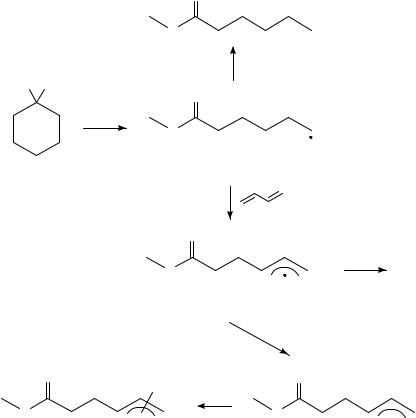
648 |
|
H. Zipse |
|
|
|
|
O |
|
|
|
O |
|
+ |
|
|
|
|
|
|
|
|
Ox. |
|
|
MeO OOH |
|
O |
|
|
|
|
|
|
|
+ Fe2 + |
|
|
|
|
|
O |
|
|
|
− Fe3 + |
|
|
|
|
|
|
(68) |
|
|
(67) |
|
|
|
|
|
|
|
|
(29) |
|
|
O |
|
|
|
O |
( ) |
Dimer. |
|
|
5 |
|
||
|
|
|
||
|
|
(69) |
|
|
|
|
− Cu+ |
|
|
|
|
+ Cu2 + |
|
|
O |
OCH3 |
|
O |
|
|
|
|
|
|
( |
) |
CH3 OH |
( ) |
|
O |
5 |
O |
5 |
+ |
|
||||
|
|
|
|
|
(71) |
61% |
|
(70) |
|
The concentration of copper(II) has a pronounced effect on the course of the reaction. In the presence of very low copper(II) concentrations, oxidation of allyl radical 69 is slow and major amounts of allyl radical dimer are formed. In the presence of very high concentrations of copper(II), radical 68 is oxidized rapidly before addition to diene can take place. An optimum yield of product 71 can therefore only be achieved at certain copper(II) concentrations. The metal-ion-promoted addition of chloramines to butadiene appears to follow the same mechanism93.
This scheme can be extended by using mixtures of dienes with electron-deficient alkenes such as acrylonitrile. Due to its nucleophilic nature, addition of radical 68 to acrylonitrile is faster than addition to butadiene. The resulting ambiphilic adduct radical then adds to butadiene to form a relatively unreactive allyl radical. Oxidation and trapping of the allyl cation by methanol lead, as before, to products such as 72 and 73, which are composed of four components: the radical precursor 67, acrylonitrile, butadiene and methanol (equation 30)17,94.
